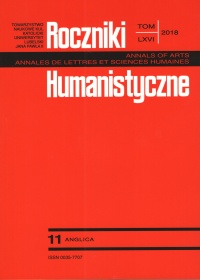Can I Say “Bububu”? Discourse Context and Meaning Construction
Abstract
This paper investigates how discourse context and dialogue goals within a discourse influence interpretation. Discourse context can be seen as a maze of lexical meanings surrounded by multitude of contextual information (infons) (cf. Wittgenstein 1958/1986, 8). This analysis tries to unweave these infons as it is a practical application of the dynamic semantic model of ÂeALIS (Alberti and Kleiber 2014). Making an interview with a patient who had surgery before, we were interested in her information management during her dialogues with her doctors. The starting point of our analysis was that when a problem occurs, we set goals to solve it. A discourse starts when the goal is set, and stops when it is fulfilled. A discourse usually has segments. Discourse coherence depends on whether these segments are relevant or not. In our interview the segments were (consecutive) dialogues forming one coherent discourse for the interviewee. Our results indicate that ÂeALIS is capable of capturing the pieces of information concerning the interlocutors’ mental states (beliefs, desires, intentions) along which coherence is created in a discourse process. We found that in a discourse, a new discourse step would follow only when—as closing one dialogue —the discourse agent’s mental state has changed. This mental state is also influenced by infons that are present in the discourse context, but are not parts of the dialogues. With this type of analysis we aim to show a line through which pragmatics can be accessible from a ReALIStic point of view.
References
Alberti, Gábor. (2011).ReALIS: Interpretálók a világban, világokazinterpretálóban [Interpreters in the world, worlds in the interpreter]. Budapest, Hungary: Akadémiai Kiadó.
Alberti, Gábor, and Judit Kleiber. 2012. “Where are Possible Worlds? Arguments for ReALIS.” Acta Linguistica Hungarica 59 (1–2): 3–26. https://doi.org/10.1556/ALing.59.2012.1-2.1
Alberti, Gábor, and Judit Kleiber. 2014. “ReALIS: Discourse Representation with a Radically New Ontology.” In Ludmila Veselovská and Markéta Janebová (eds.). Complex Visibles Out There. Olomouc Modern Language Series 4, 513–528. Olomouc, Czech Republic: Palacký University.
Alberti, Gábor, Judit Kleiber, and Eszter Kárpáti. 2017. Reális (ReALIS) kép a másik elméjéről [ReALIS-tic picture of others’ minds]. In Miklós Márton, Gábor Molnár, János Tőzsér (eds.). Más elmék, 237–268. Budapest, Hungary: l’Harmattan.
Asher, Nicholas, and Akex Lascarides. 2003. Logics of Conversation. Cambridge, UK: Cambridge University Press.
Bigi, Sarah. 2016. Communicating (with) care. Amsterdam, Berlin, Washington, DC: IOS Press.
Bruner, Jerome. 1991. “The narrative construction of reality.” Critical Inquiry 18 (Autumn): 1–21. https://doi.org/10.1086/448619. Retrieved from http://www.semiootika.ee/sygiskool/tekstid/bruner.pdf.
Fodor, Jerry A. 1985. “Précis of the modularity of mind.” Behavioral and Brain Sciences 8 (1), 1–42. https://doi.org/10.1017/S0140525X0001921X.
Herman, David. 2013. “Cognitive narratology.” In Peter Hühn, John Pier, Wolf Schmid, and Jörg Schönert (eds.). Living handbook of narratology, 30–43. Hamburg, Germany: Hamburg University. Retrieved from The Living handbook of narratology. Accessed 07.11.2018. http://www.lhn.uni-hamburg.de/article/cognitive-narratology-revised-version-uploaded-22-september-2013.
Kamp, Hans, Josef van Genabith, and Uve Reyle, U. 2011. “Discourse Representation Theory.” In Dov M. Gabbay and Franz Guenthner (eds.). Handbook of Philosophical Logic, 125–394. Berlin, Germany: Springer.
Kárpáti, Eszter. 2015. “Az orvosi nyelvhasználat szerepéről [The role of medical language use].” In: Tamás Gecső and Csilla Sárdi (eds.), Nyelv, kultúra, társadalom, 119–125. KJF, Budapest, Hungary: Székesfehérvár–Tinta.
Kárpáti, Eszter, and Judit Kleiber. 2017. “?Fogalmi ?verbális. Verbálisan rögzített diskurzusok pragmaszemantikai elemzése [?Dictum. Pragmasemantic analysis of verbal discourses].” Officina Textologica 20, 79–89. Debrecen, Hungary: Institute of Hungarian Linguistics, University of Debrecen.
Kecskes, Istvan. 2013. Intercultural communication. Oxford, UK: Oxford University Press.
León, Carlos. 2016. “An architecture of narrative memory.” Biologically Inspired Cognitive Architectures 16: 19–33. https://doi.org/10.1016/j.bica.2016.04.002. Retrieved from https://www.researchgate.net/publication/301756442_An_architecture_of_narrative_memory.
Macagno, Fabrizio, and Sarah Bigi. 2017. “Analyzing the pragmatic structure of dialogues.” Discourse Studies 19 (2): 148–168. https://doi.org/10.1177/1461445617691702.
Pléh, Cs. (1999). “Hozzájárulhatnak-e az empirikus pszichológiai kutatások a nyelv–gondolkodás viszony filozófiai problémájának megoldásához? [Can empirical psychological research contribute to the philosophical problem of language-thinking relationship?].” In Katalin Neumer (ed.). Nyelv, gondolkodás, relativizmus, 35–165. Budapest, Hungary: Osiris.
Sperber, Dan, and Deirdre Wilson. 1995/1986. Relevance. 2nd ed. Cambridge, MA: Blackwell.
Szilas, Nicolas. 2015. “Towards narrative-based knowledge representation in cognitive systems.” In Proceedings of the 6th workshop on computational models of narrative, 133–141. DROPS. Dagstuhl Research Online Publication Server. Accessed 07.11.2018. http://drops.dagstuhl.de/opus/volltexte/2015/5287/pdf/16.pdf.
Wittgenstein, Ludwig. 1958/1986. Philosophical Investigations. Oxford, UK: Blackwell.
Wilson, Deirdre. 2016. “Reassessing the conceptual–procedural distinction.” Lingua 175–176: 5–19. https://doi.org/10.1016/j.lingua.2015.12.005.
Wilson, Deirdre, and Robyn Carston. 2007. “A Unitary Approach to lexical pragmatics: relevance, inference and ad hoc concepts.” In Noel Burton-Robert (ed.). Pragmatics, 230–259. London, UK: Palgrave. https://doi.org/10.1057/978-1-349-73908-0_12.
Copyright (c) 2018 Roczniki Humanistyczne

This work is licensed under a Creative Commons Attribution-NonCommercial-NoDerivatives 4.0 International License.





